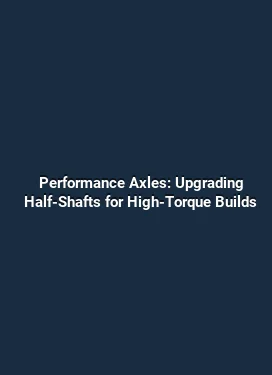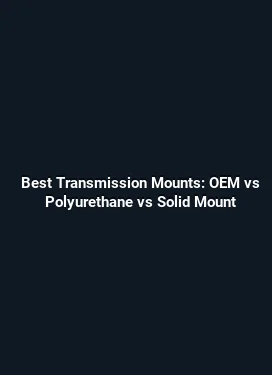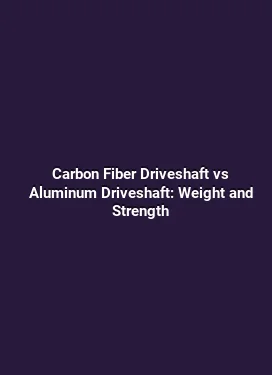Drivetrain Efficiency: How to Reduce Power Loss Through the Axles
drivetrain efficiency is a critical factor in overall vehicle performance, fuel economy, and responsiveness. While much attention is paid to engines and transmissions, significant power losses occur along the axles, differentials, and driveline components that connect the engine to the wheels. This comprehensive exploration delves into the mechanisms of power loss within the axle assembly, identifies primary loss sources, and presents practical, evidence-based methods to minimize these losses without compromising reliability or drivability.
Understanding Power Loss Through the Drivetrain

Power is delivered from the engine through a sequence of interfaces, each introducing some level of friction or inefficiency. The term drivetrain efficiency reflects the percentage of engine power that reaches the wheels as usable torque and motion. While high-efficiency systems are the goal, real-world drivetrains contend with parasitic losses that accumulate along the path from crankshaft to axle shaft. Loss mechanisms include bearing drag, seal friction, gear mesh inefficiencies in differentials and transmission, lubrication dynamics, and energy dissipated through drivetrain angles and vibrations. Recognizing these components helps in diagnosing performance issues and identifying targeted improvements.
In modern vehicles, the drivetrain is designed to balance efficiency with durability, noise, vibration, and harshness (NVH) considerations. For enthusiasts and engineers alike, the focus is not merely to reduce friction but to optimize the way moving parts interact under varying loads, speeds, and operating temperatures. The interplay between lubricant viscosity, bearing preload, and gear geometry often determines the magnitude of losses during high-torque scenarios such as acceleration or towing, as well as during steady-state cruising where frictional forces dominate.
Key Factors Contributing to Axle Power Loss
The axles and adjacent components introduce several loss pathways. Each pathway presents opportunities for improvement through design choices, material selection, and maintenance practices. A structured examination of major contributors is essential for a targeted optimization approach.
Bearings and Seals: Friction at the Interface

Bearings support rotating elements while seals prevent oil leakage and contamination. The friction generated at bearing surfaces translates into heat and energy loss. Preload specifications, bearing material, and race geometry influence rolling resistance. Excessive preload increases drag and reduces efficiency, while insufficient preload can lead to play and wear, elevating friction over time. Selecting bearings with optimized contact geometry and employing advanced coatings can reduce hysteresis and improve life-span under load cycling.
Seals add another layer of resistance, especially in high-temperature environments where elastomeric materials may deform or wear. Proper seal design minimizes friction without compromising sealing performance. Routine inspection of seals for hardening, cracking, or misalignment helps sustain low drag across the drivetrain life cycle.
Lubrication Regimes: Viscosity, Temperature, and Flow
Lubricants reduce metal-to-metal contact and carry away heat generated by friction. The choice of lubricant, including viscosity grades and base oil chemistry, directly impacts efficiency. Heavier viscosity oils may provide robust film strength but can increase flow resistance and hysteresis, particularly at low temperatures. Conversely, lightweight oils reduce drag but may not sustain an adequate film at extreme loads. The lubrication regime shifts with speed, torque, and ambient temperature, making it crucial to match lubricant performance with operating conditions.
Lubrication also influences gear mesh efficiency in differentials and transmissions. Inadequate lubrication leads to heat buildup, which elevates oil viscosity and further worsens energy losses. Proper lubrication intervals, filter cleanliness, and oil temperature management are essential for maintaining consistent efficiency over time.
Differentials and Gear Mesh: Torque Transmission with Minimal Loss
The differential and axle gear trains are designed to transfer torque from the driveshaft to the wheels while accommodating wheel speed differences. Gear mesh inefficiencies arise from non-ideal tooth profiles, backlash, and wear. Differential designs, such as open, limited-slip, or electronically controlled units, introduce varying levels of drag depending on lockup, road conditions, and traction requirements. Heat from gear mesh, particularly under high-load conditions, can alter clearances and lubrication behavior, magnifying losses unless managed through cooling and precise manufacturing tolerances.
CV Joints and Driveline Angles: Flexing Under Load
Constant velocity (CV) joints and driveline angles influence power transfer during cornering and suspension movement. As the drivetrain angles change with ride height and suspension travel, CV joint efficiency can vary. Worn boots, degraded grease, or contaminated CV joints introduce additional friction and potential binding, especially during low-speed, high-torque maneuvers. Ensuring proper joint preload, lubrication, and boot integrity helps maintain consistent efficiency across driving conditions.
Axle Shafts and Differential Coolant: Thermal Management and Material Considerations
Axle shafts themselves contribute to losses through their mass, balance, and surface finish. High-strength steels and alloys with optimized tempering reduce internal friction while preserving strength. Heat from continuous operation can raise lubricant temperatures and affect viscosity, increasing drag. Efficient thermal management, including differential cooling for performance-oriented setups, helps maintain stable operating temperatures and preserves efficiency over extended duty cycles.
Strategies to Improve Transmission and Drivetrain Efficiency
Practical optimization requires a combination of design insight, maintenance discipline, and real-world testing. Below are actionable strategies that address the most impactful loss sources while preserving reliability and drivability.
Optimizing Gear Ratios and Torque Path
Transmission and axle gearing define the torque and speed relationship delivered to the wheels. Thoughtful gear ratio selection can minimize engine operating points that experience high drag or torque peaks, reducing heat and friction in the driveline. For performance hybrids or electric-assisted systems, the objective is to align torque delivery with accelerator input to avoid abrupt transitions that spike losses. In manual and automatic transmissions, ensuring gear mesh alignment and proper preload minimizes micro-movements that waste energy during load changes.
Low-Drag Driveline Design and Lightweighting
Iterative design approaches focus on reducing inertial losses and windage along the driveline. Lightweighting components such as hollow-stub axle cores, optimized shaft diameters, and high-strength lightweight alloys reduces rotational inertia and improves responsiveness. However, the gains must be balanced against strength, fatigue life, and NVH targets. Advanced coatings and low-friction surface finishes on gears, bearings, and seals also contribute to measurable efficiency improvements by lowering parasitic drag in critical contact zones.
Lubricant Selection and Temperature Management
Choosing the right lubricant involves balancing film strength, viscosity, and shear stability with operating temperature ranges. Synthetic blends or full-synthetic lubricants with excellent oxidation resistance and shear stability help maintain consistent film thickness. Implementing differential cooling, oil coolers, or heat exchangers preserves lubricant properties and prevents viscosity drift, which directly affects friction losses and overall efficiency during high-demand driving.
Maintenance Practices for Sustained Efficiency
Regular inspection of bearings, seals, and CV joints prevents stealthy efficiency losses due to wear and contamination. Alignment checks, torque checks, and boot inspections reduce drag caused by misalignment or degraded lubricants. Filtration performance and oil cleanliness are essential; contaminated oil increases abrasive wear and can destabilize lubrication regimes, leading to elevated friction and fuel consumption over time.
Material Choices and Manufacturing Tolerances
Material science advances enable higher strength-to-weight ratios and better wear resistance. Precision manufacturing reduces surface imperfections, reducing micro-wear and friction. Tight tolerances ensure accurate gear meshing and consistent preload in bearings, resulting in lower parasitic losses across the drivetrain. Engineers often leverage finite element analysis and tribology simulations to optimize contact mechanics and minimize energy dissipation.
Measurement, Monitoring and Real-World Diagnostics
Quantifying drivetrain efficiency requires a combination of instrumentation and data interpretation. Modern vehicles employ a network of sensors and diagnostic tools that monitor temperatures, speeds, torques, and oil pressures. Interpreting this data allows technicians to identify drift in efficiency, correlate it with specific operating regimes, and implement corrective actions with confidence.
Power Loss Diagnostic Methods
Diagnostic approaches include comparing input and output shaft speeds to calculate torque transmission efficiency under various loads. Temperature profiles of housings and differential oil provide indirect indicators of frictional heat. In some cases, roll-on torque measurements during controlled road tests help quantify how changes in gearing or lubrication affect overall efficiency. Advanced diagnostics may involve transient testing to capture peak drag during acceleration or uphill conditions.
Telemetry, Sensors, and Predictive Maintenance
Connection of wheel speed sensors, differential temperature sensors, and lubricant condition monitors enables continuous assessment of driveline health. Predictive maintenance models use historical data to forecast wear trends and schedule proactive maintenance before noticeable efficiency losses occur. Real-time alerts for abnormal vibration signatures or oil temperature anomalies help prevent prolonged exposure to damaging conditions that increase energy dissipation.
Real-World Case Studies: Lessons from the Field
Case studies illustrate how small design changes can yield meaningful improvements. For example, a vehicle program that swapped to a lower-friction differential lubricant and refined differential casing geometry achieved measurable reductions in parasitic losses during steady-state cruising. Another case highlights how improved CV joint grease formulations reduced drag during sustained cornering at high speeds, contributing to better overall efficiency without compromising steering feel or NVH. These examples underscore the value of an integrated approach that combines lubrication science, mechanical design, and precise manufacturing.
In live testing, the relationship between efficiency and operating conditions becomes evident. Accelerated wear tests reveal how lubrication performance degrades with temperature, and how that degradation manifests as higher friction and heat. The insights gained guide targeted interventions, from lubricant upgrades to cooling enhancements and bearing retightening procedures. The cumulative effect of these adjustments often translates into more consistent efficiency across a wide range of driving scenarios, including urban stop-and-go traffic, highway cruising, and heavy-duty towing.
Additional Considerations and Emerging Trends
As vehicle architectures evolve, so do the strategies for minimizing power loss. Electrification introduces new dynamics in torque delivery and energy recovery strategies, while hybrid configurations require careful management of torque split and regenerative braking to preserve overall drivetrain efficiency. Terrestrial and material innovations, such as advanced ceramic bearings and low-friction coatings, hold promise for reducing internal resistance further while maintaining durability under demanding conditions. At the same time, real-world data collection and AI-driven analytics enable more precise identification of loss hotspots, enabling continuous, data-informed improvements across the drivetrain ecosystem.
Understanding the interplay between track conditions, load profiles, and component aging helps professionals tailor maintenance plans and design choices for specific vehicle applications. For example, performance off-road applications demand robust, heat-tolerant lubrication and cooling strategies, while luxury vehicles may prioritize smoothness and minimal NVH without sacrificing efficiency. The common thread is a disciplined approach to measuring, diagnosing, and iterating on driveline components to reduce energy losses wherever feasible.






